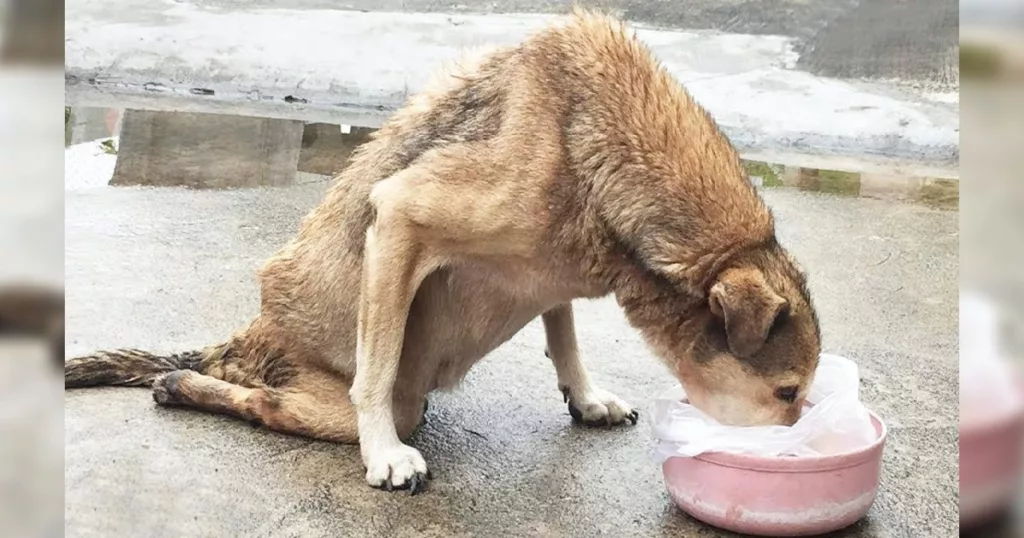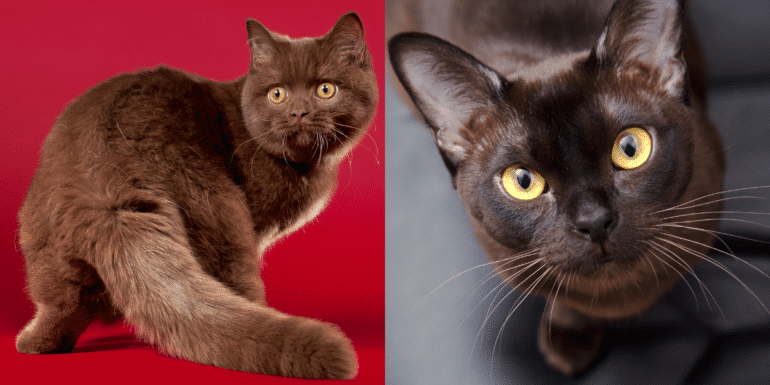
Brown may be a common color for dogs and human hair, but can you remember the last time you saw a fully brown cat? Not a brown tabby cat, but a solid, brown-colored cat. Brown cats are notoriously rare, though profoundly lovable as our feline friends are only possible due to a genetic mutation that strives to eliminate black pigmentation in the cat’s coat and coloring. This results in what we come to know as brown cats or more frequently referred to as the purebred Havana Brown and the Oriental Shorthair cat breed. 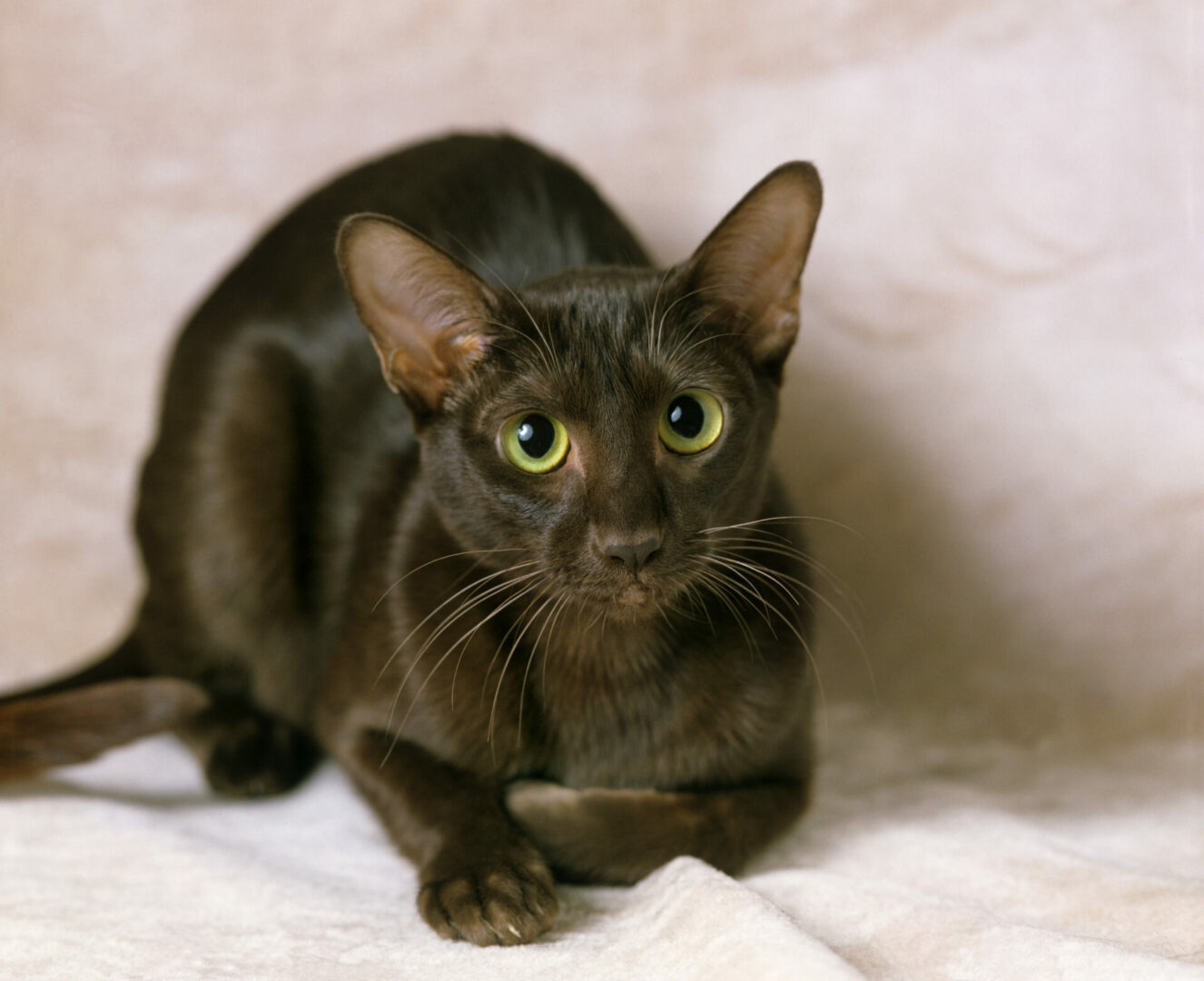
Gene Mutation
The color “brown” in cats is only possible due to a genetic mutation that focuses on the gene that produces the color “black”. This genetic mutation aims for this black pigment gene and strives to fully reduce this pigmentation in the cat’s coat and coloring. The genetic mutation is rare, makings its way through the passage of recessive genes, resulting in the color “brown”. It’s not common to find this gene variant in cats, but it’s purposely bred in cats like the Oriental Shorthair and the Havana Brown cat breeds to enrich this rare and magnetic coloring.
Brown Cat Breeds
Though rare, there are recognized cat breeds that have been purposely bred to showcase this wondrous feline coloring. You can find some examples of this in the furry felines listed below!
Havana Brown
Fondly referred to as “Chocolate Delights” (how cute is that?!), the Havana Brown is commonly recognized for its mesmerizing green eyes and decadent, chocolate brown coloring. Many have been quoted saying that there’s no going back once you own, or more commonly quoted as being “owned” by, the Havana Brown. Refreshingly affectionate with a sharp intellect, the Havana Brown cat loves to be included in every activity in the home, showing companionship with other pets and family members.
A Bit Of History
Its origins date back to England, where it was purposely bred with domestic black-colored felines and Siamese cats to obtain the breed’s now adored chocolate-brown coloring. In the 1950s, the Havana Brown cat was introduced to North America where its heritage has been maintained in comparison to the Havana Brown cats of England that favor the Siamese heritage.
Appearance
Elegant in grace and of medium-firm stature, the Havana Brown cat is mostly recognized for its rare and stunning coloring as well as the shape of its head. With hypnotizing green eyes, this brown cat has a unique muzzle distinct to its breeding—a wide, rounded muzzle, frequently imagined with the appearance of the end of a light bulb (we promise, it’s way cuter than that sounds!). And don’t forget the large ears often set forward in a sign of alertness!
Activity Level
In comparison to other shorthair cat breeds, this brown cat is average in recorded activity level. The Havana Brown cat loves playtime with its owner or other friendly felines. Don’t be too surprised if you find your Havana Brown cat randomly sprinting around the house!
Personality
Curious creatures, like most felines, the Havana Brown is known to be inquisitive in nature. They use their paw as a tool to investigate new sensory or environmental developments. Many Havana Brown cat owners admit to their loveable feline using their paws to grab the attention of their human companions, or to even show affection! Nothing quite like a loving boop to the face!
Grooming
The Havana Brown cat loves attention, so you won’t have to fight tooth and claw to groom this affectionate feline. Though this brown cat breed doesn’t require a ton of grooming sessions, maintenance is required for a happy, clean, and healthy kitty. As a shorthaired breed, this brown cat should be groomed with a soft rubber brush, according to The Cat Fanciers Association, back and front claws clipped at a safe measurement, and the insides of its ears cleaned to prevent any ear or bacterial infections. 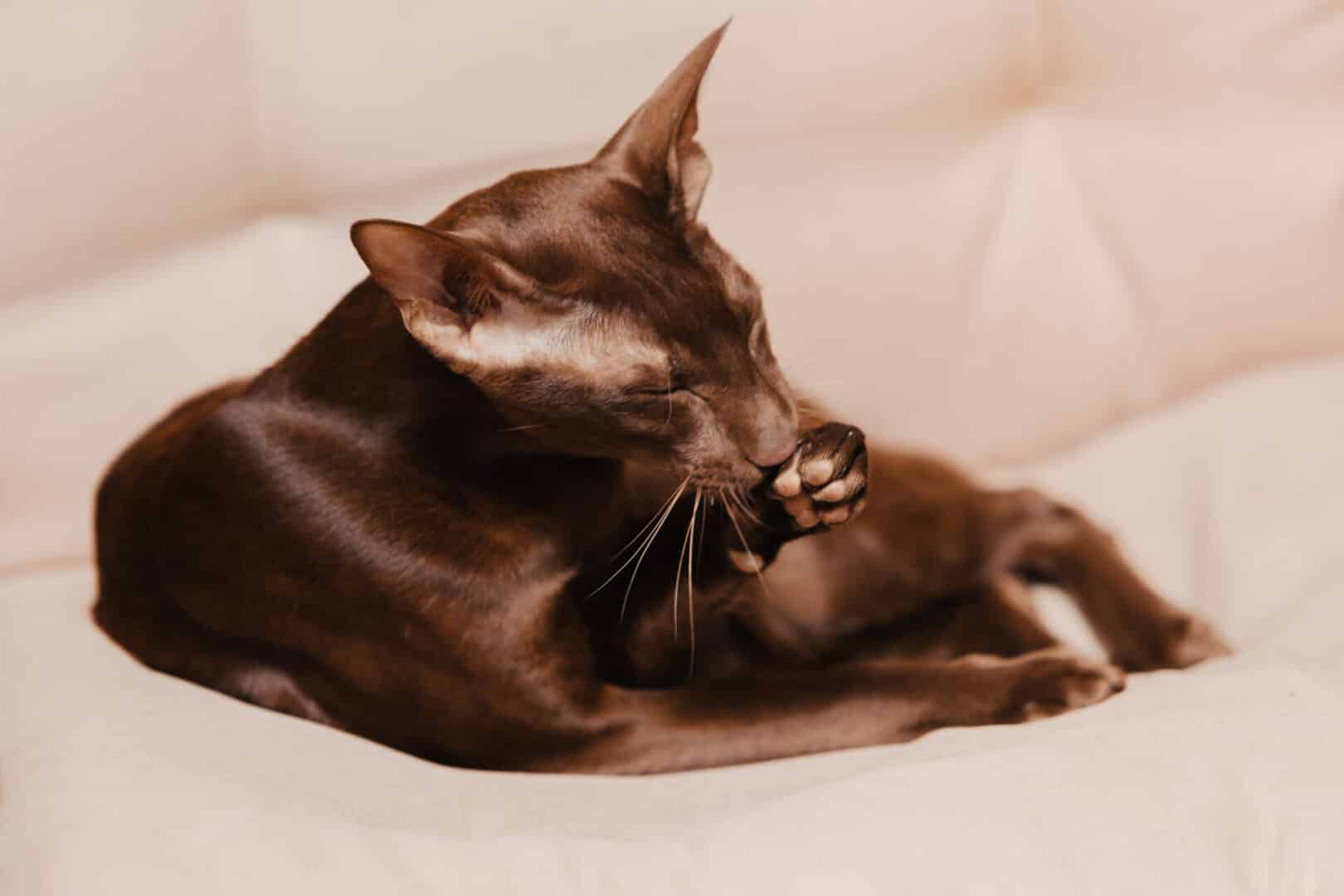
Oriental Shorthair
The Oriental Shorthair was created to explore all ranges of possibilities concerning color and pattern in a feline’s coat. And it was successful! There are over 600 alternatives to coat length, pattern, and color to choose from in the Oriental Shorthair breed and, most affectionately, the rare brown coloring we’ve grown so fond of.
A Bit Of History
With a foundation and history in the Siamese pedigree, the Oriental Shorthair gained much of its popularity in 1977. The diverse breed boasts “over 600 color, pattern, and coat length combinations”, according to The Cat Fanciers Association, including this elegant breed with all the other rare brown cats.
Appearance
Sleek, yet sturdy, in musculature, the Oriental Shorthair comes in all manner of coloring and pattern, even as a rare brown cat! This agile cat boasts almond-shaped eyes, big flared ears, and an angularly-shaped head with long and slender legs and tail.
Activity Level
The activity level of these loyal felines depends on the amount of attention you provide them. When unable to receive the requiredaount of attention they desire, the Oriental Shorthair can prove to be a tad destructive in its boredom or they can find something small that snags their attention to enjoying for hours on end. Playing with these spirited felines will improve their dedication and dreary mood if they don’t receive the attention they so desire from their chosen one. And, if anything, giving them much-needed petting and grooming time will do the intended job of showing these sweet kitties that you care.
Personality
For these diversely colored and patterned cats, it’s not uncommon for them to attach themselves to companions they define as “theirs”. Engaged in their attention, these fond felines will love to share moments with you, whether it be sitting in the room with you while you enjoy a new tv show or when doing chores around the house. When they choose who’s “theirs”, they make sure you know it, so be prepared when they openly communicate that you’ve taken too long at the grocery store when you come back home to them!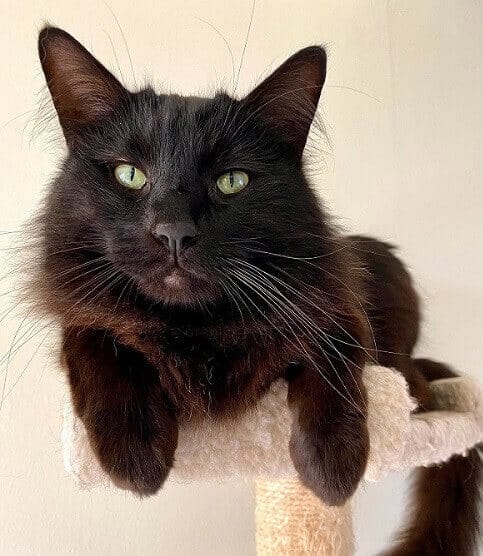
York Chocolate
Occasionally referred to simply as “York”, the York Chocolate cat breed is an American breed of brown cat. Named after the state of New York, where the breed was securely founded in 1983, the York Chocolate was not wholly recognized by reputable cat associations and registries. The breed has since been wholly recognized by the World Cat Federation, located in Germany. By 1990, the York Chocolate brown cat breed was accepted by the American Cat Fanciers Association and the Cats Fanciers Federation as an experimental breed. In 1995, the Canadian Cat Association granted championship status to the York Chocolate breed. To this day, only a number of breeders are allowed while acceptance of this beautiful breed is worked to be expanded on.
A Bit Of History
It all started on a goat dairy farm (what a way to start a story!). Fathered by a domestic long-haired black cat with a long-haired white and black coated mother with Siamese ancestry, the breed of York Chocolate was founded in 1983 by Janet Chiefari who noticed the intricate coat coloring and started her own breeding program to exemplify this beautiful breed.
Appearance
Firm in musculature, the York Chocolate is a large, brown cat. Similar to a farm cat based on its structure and appearance, this breed of brown cat could come in a variety of colors: lavender, a rich chocolate brown, or a variety of the two. Recognized for its sported semi-long fur coat and puffed tail, the York Chocolate is a stunning breed of brown cat that should be further recognized by cat associations for its warm and fluffy chocolate appearance.
Activity Level
Moderate in activity level, the York Chocolate breed started out on a goat dairy farm, a farm cat used to hunt and control rodent and pest infestations. This brown cat thoroughly enjoys spending time with its human with designated playtime to keep it active and content. Still, the highly skilled hunters, York Chocolate cats remain to be great in pest control on farms or other locations, which can help satiate their need for activity.
Personality
Friendly, affectionate, and even-tempered, the York Chocolate is a brown cat content with snoozing on its human’s lap. These brown cats are loyal and affectionate with their humans, yet surprisingly independent, in contrast. The affection of these furry felines tends to overpower their independence as they enjoy quality time with their human, whether it be getting their beauty sleep or encouraging much-needed petting time. 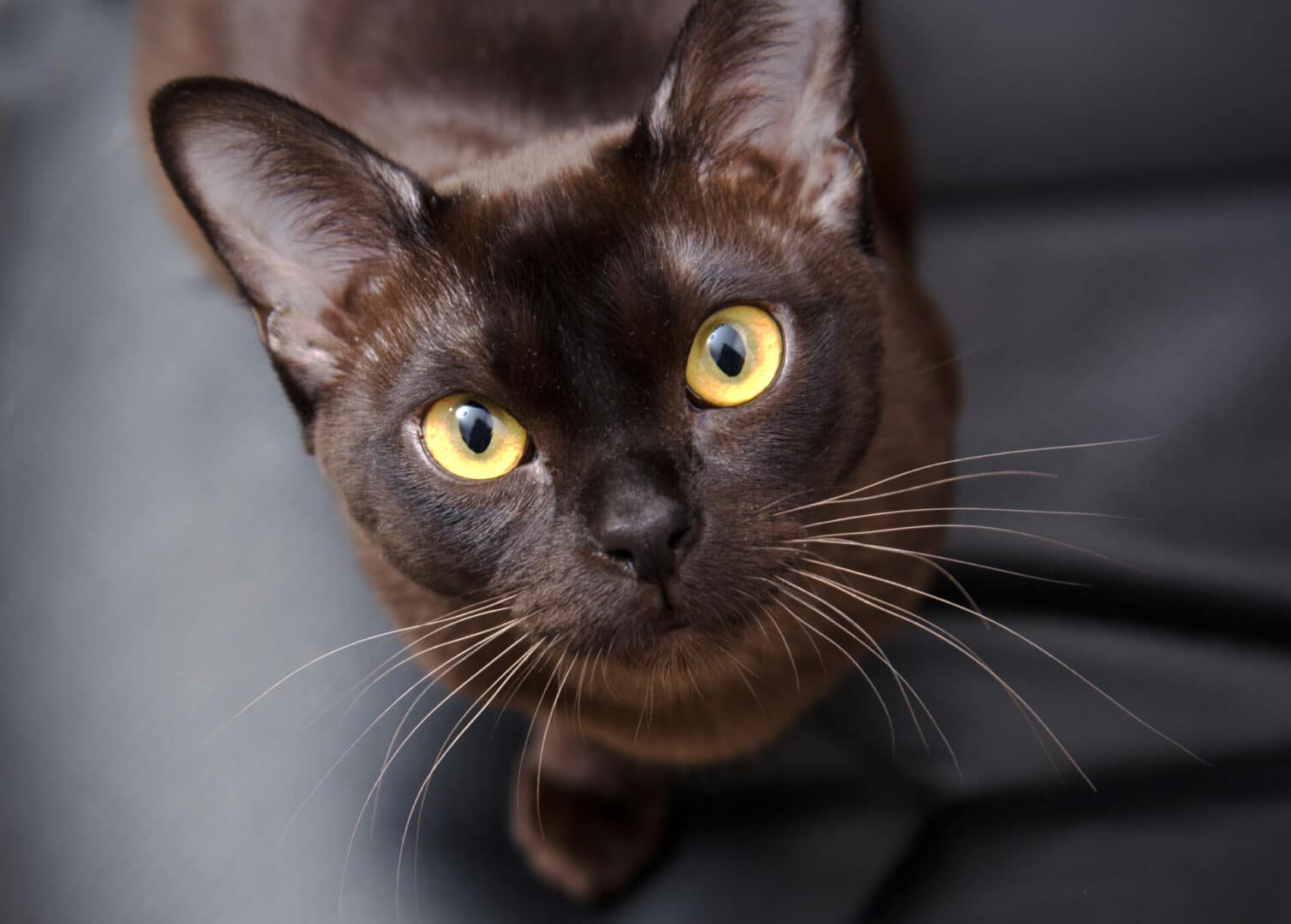
Burmese Cat
This recognized breed of the brown cat came to the United States in 1930 and was subsequently bred with Siamese cats to achieve a unique and rare solid brown coloring. This type of coloring is often termed as “sable”.
A Bit Of History
Dr. Joseph Thompson is the reason this astounding brown cat breed was founded. In 1930, Thompson came back to San Francisco from Burma with a small feline with walnut brown coloring. Succinctly, Thompson began to achieve the desired solid brown coloring by breeding this walnut brown cat, that he named Wong Mau, with Siamese cats. Since the founding of this magmatic breed, the solid brown Burmese cat, and with some controversial variants of colors, was accepted by the Cat Fanciers Association.
Appearance
Surprisingly hefty in weight, the Burmese are shorthaired cats that are extraordinarily soft in texture. Show cats have shorter bodies and heads that are rounder compared to non-show Burmese cats. With wide and expressive eyes, this feline’s appeal has pulled over many a person that doesn’t hold a fondness for felines.
Activity Level
Playful and spirited, the Burmese cat is incredibly athletic and graceful. Don’t be surprised if your Burmese cat is jumping heady heights or managing heroic feats in their many quests and adventures of their humble abode.
Personality
Massively affectionate to their human counterparts, Burmese cats enjoy spending as much time as possible with their companions. And it’s still never enough! They’re incredibly playful and love playtime when provided the opportunity to engage in the activity. These friendly felines are also known to be great with children as a bonus! Burmese cats tend to play an active role in their household, especially the females, while on the other hand, the males will do so from the comfort of a warm lap—namely yours.
Grooming
There’s no need for grooming with this shorthair cat. Due to their silky, shorthaired fur coat, the Burmese cat only requires much-needed petting time to absolve the otherwise unnecessary need of a grooming session. 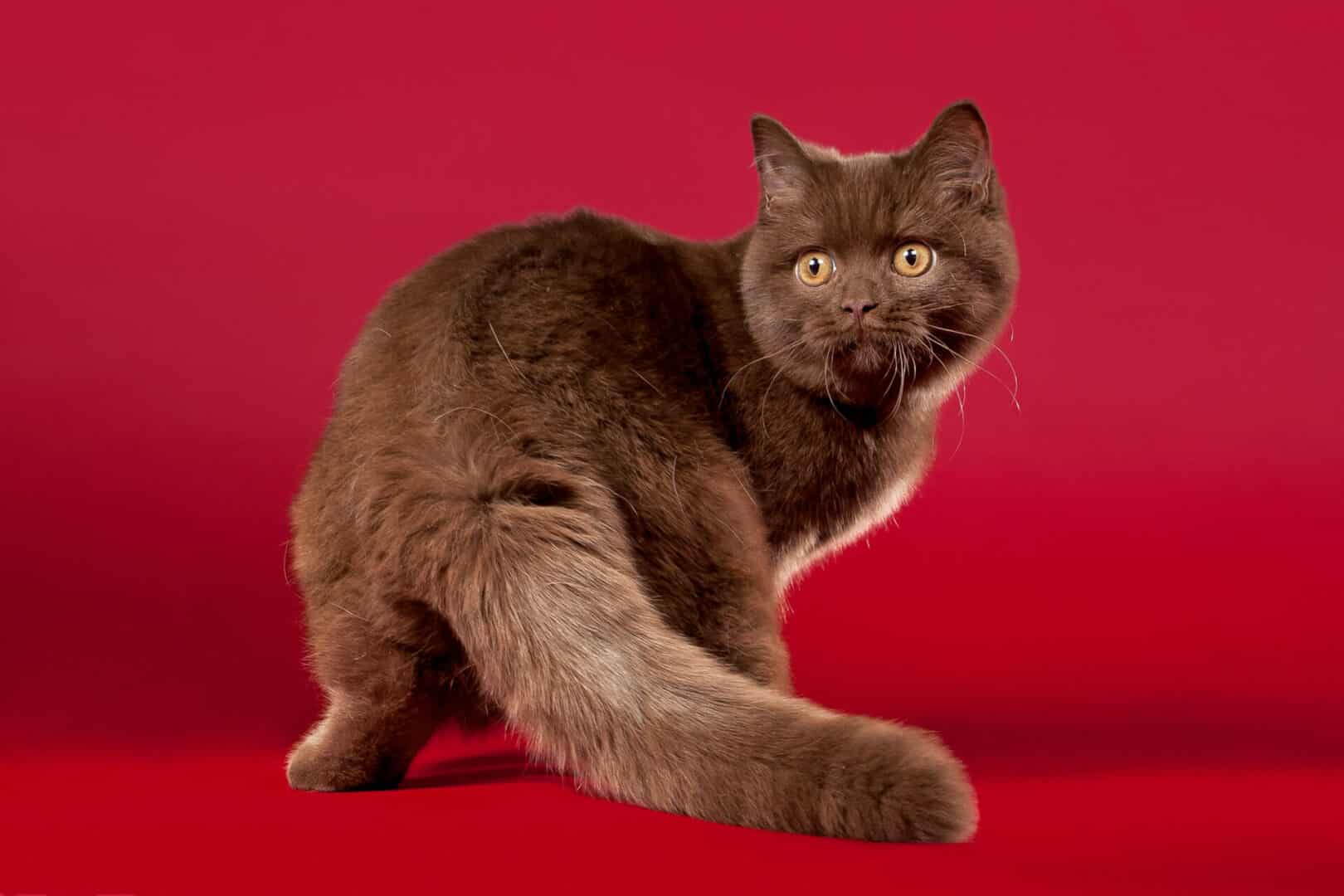
British Shorthair
Considered to be calm compared to other shorthair cats, the British Shorthair comes in a variety of colorings. Most astoundingly adored is the Chocolate British Shorthair, for its rare coloration founded in cross-breeding with chocolate-colored Persians.
A Bit Of History
Deemed the oldest English breed of feline, the British Shorthair’s history can be followed back to the domesticated cats of Rome where they were tasked for their innate hunting ability. Compared to today, the breed is more known to have a voracious fondness for their food and their rather comical ineptitude for agile grace. Once brought over to Europe, the breed of British Shorthair cat started as alley or street cats. Breeders took on the task of rejuvenating the bloodline, and its consequently adored “teddy bear-like” features, and succeeded in obtaining the breed’s recognition in 1980.
Appearance
Referred to as the “teddy bears” of cat breeds, the British Shorthair is large in stature compared to most cats (but still not as big as the Maine Coone). With large, round eyes and sturdy stature, this fond breed of a feline is unsurprisingly popular.
Activity Level
The British Shorthair isn’t known for being graceful in its agility. In fact, this breed is opposingly known to be, amusingly, clumsy at the best of times. Quite contrasting to its historical heritage.
Personality
Calm in temperament when fully matured, the British Shorthair is rather easygoing and adaptable. These felines become fondly attached to the humans they choose as “theirs”. They’re great companions for anyone searching for a reliable, calm, and affectionate pet. 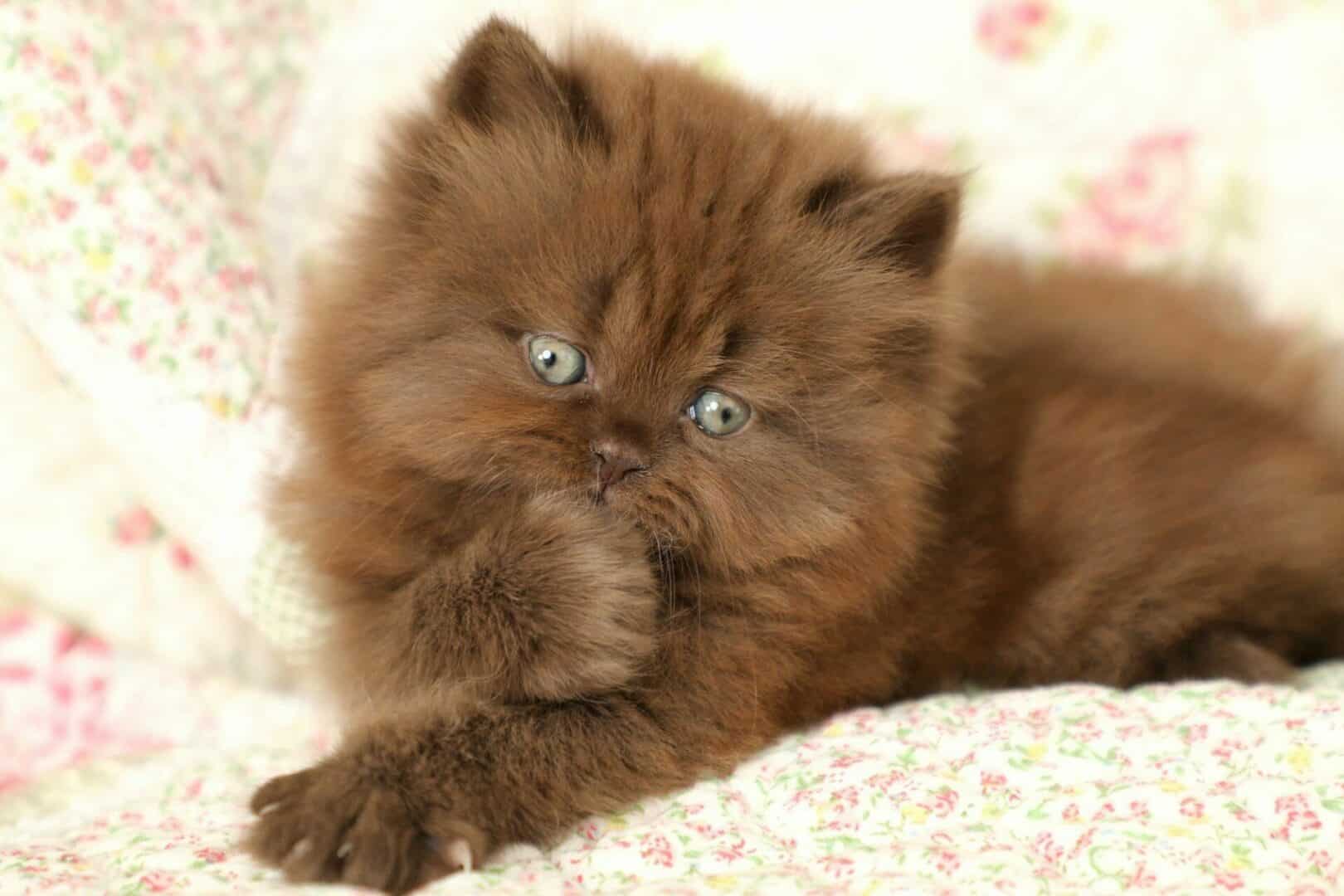
Persian
Fun fact alert! The breed of Persian cat, or solid-colored Persian cats anyways, are genetically tabbies. When the Persian cat is a kitten, it’s interesting to note the tabby markings that show their genetic history. As the kittens mature into adulthood, the tabby markings disappear. If you remember from the British Shorthair information listedaove, the chocolate Persian provides the genetics necessary to obtain the desired brown coloring in the chocolate-colored British Shorthair.
A Bit Of History
With a line of history tracing back to 1520, and further still, the Persian cat’s heritage is, surprisingly, unknown. Some believe that the Persian cat originated from a mixture of longhair cats from Persia and Russia. Ancestors of today’s Persian cat were brought to Europe around 300 years ago, where the breed was entered into one of the first British cat shows in 1871. Eventually, the breed made its way to America, where the British, solid-color Persians would inspire American breeders. In 1957, the very first chocolate Persian was born, its sire a Havana Brown and its dam a Siamese and blue Persian cross. Following the popularity of the chocolate Persian, the Cat Fanciers Association gave the breed coloring recognition in 1981.
Appearance
The Cat Fanciers Association recognizes the “ideal” Persian to be “a heavily boned, well-balanced cat with a sweet expression and soft, round lines.” Persians have long fur coats that require constant grooming to prevent knots and matting.
Activity Level
The Persian cat is more often than not likely to lounge on a windowsill or chair rather than spend its time sprinting around the house and jumping onto shelves. Though, they do manage to be active when encouraged to do so with exciting playtime.
Personality
Persian cats are often quiet cats with a loving disposition. They’re not the type of feline to require, or demand, constant attention, and are known to be reservedaound strangers. Instead, these felines prefer to lounge and relax, while choosing to be quite affectionate with their humans.
Grooming
As Persians have signature long-haired coats, they require quite a bit of maintenance with grooming. If not handled consistently, the coat can become quite the hassle to correct and manage. It’s recommended that the Persian cat’s coat be combed out every day to prevent knotting and tangles. To prevent and remove stains, the face should be cleaned daily. A bath is necessary a minimum of once every two weeks, or the recommended requirement of once a week, to keep the Persian cat’s coat fresh and rejuvenated.
Conclusion
These are only some of the few breeds, like the Scottish Fold, Swiss Mountain Cat, and Devon Rex, of feline that can be uniquely classified as rare “brown cats”. Some breeds are rare in that they only hold the singular brown coloring, whilst others exemplify their diversity by permitting other patterns and coloring to the breed, like the Oriental Shorthair! We hope this article was informative in its content on “Brown Cats”. Share this article with friends and family looking to learn more about the rarity and history of the “Brown Cats”.
Khách mời đóng góp·19 tháng 2 năm 2022· Cập nhật lần cuối: Ngày 7 tháng 9 năm 2023


